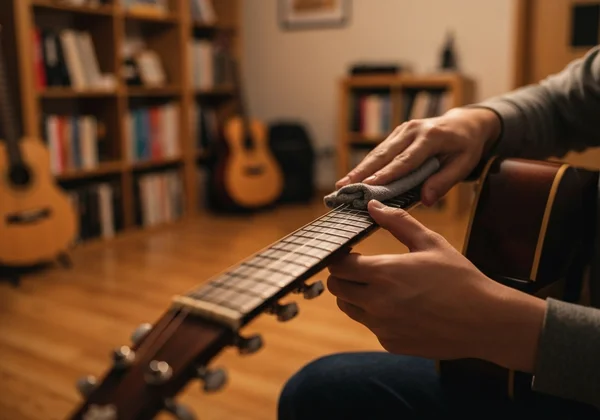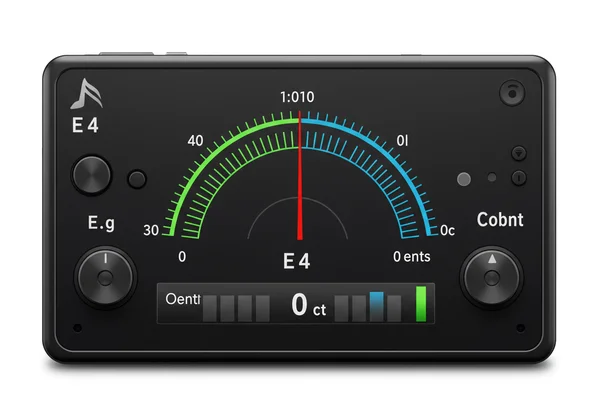Master Your Pitch: The Tuner Ninja Guide to Lasting Tuning Stability
There's nothing more frustrating for a musician than an instrument that refuses to cooperate. You spend time getting every string to perfect pitch, only to have it drift sharp or flat minutes later. This constant battle can derail practice sessions, ruin recordings, and undermine your confidence. If you've ever asked yourself, Why won't my guitar stay in tune?, you're not alone. The good news is that achieving solid tuning stability is entirely possible, and it starts with understanding the root causes.
This guide will act as your dojo, training you to diagnose and fix the seven most common reasons your instrument loses its pitch. We'll equip you with the knowledge to maintain your instrument like a pro. Once you've mastered these fixes, you’ll need a precise and reliable tool to keep you on target, which is where a powerful and free tuner ninja becomes your most trusted ally.
Understanding Tuning Stability: Your Key to Accurate Online Tuning
Before we dive into the fixes, let's clarify what we mean by tuning stability. It’s the ability of a stringed instrument—be it a guitar, bass, ukulele, or violin—to hold its intended pitch for an extended period of playing. An instrument with good stability will only require minor adjustments between sessions, not after every song.

What Does "Staying in Tune" Really Mean?
At its core, "staying in tune" means each string consistently vibrates at its target frequency (measured in Hertz). When you tune a standard guitar, you're setting the low E string to 82.41 Hz, the A string to 110 Hz, and so on. Achieving this requires not just initial accuracy but also a setup that prevents the strings from slipping or reacting negatively to physical stress. This is the foundation of achieving perfect pitch across your entire fretboard.
The Impact of Poor Tuning on Your Music
Inconsistent tuning does more than just sound bad; it fundamentally hinders your musical growth. Chords sound muddy and dissonant, melodies lose their emotional impact, and playing with other musicians becomes nearly impossible. Poor tuning can even affect your intonation, meaning notes might be in tune on open strings but go sharp or flat as you play higher up the neck. This inconsistency can make you believe your playing is flawed when the real culprit is your instrument's setup.
The 7 Common Problems Making Your Instrument Lose Pitch
Think of yourself as a tuning ninja, silently identifying the hidden enemies of pitch. Here are the seven most common culprits you need to confront.
New Strings Stretching: An Unavoidable Initial Phase
This is the number one cause of tuning issues for beginners and pros alike. Freshly installed strings are under immense tension for the first time and are made of materials that will naturally stretch. This initial stretching period can last anywhere from a few hours to a few days, during which the strings will constantly go flat. It's a normal process, but one that requires patience and frequent re-tuning.
Improper String Winding on Tuning Pegs
How you wind the strings around the tuning posts is critical. Too many wraps can create layers that slip and shift against each other, causing the pitch to drop. Too few wraps, and the string might not have enough grip to hold its tension, leading to slippage at the post. A messy, overlapping string winding technique is a direct invitation for tuning instability.

Friction at the Nut or Bridge Saddles
Your strings make contact with the instrument at two key points: the nut (at the top of the neck) and the bridge saddles (on the body). If the slots in the nut and bridge are too tight or have burrs, the string can get pinched. When you tune up, the tension builds unevenly. When you bend a string or play aggressively, the string can suddenly slip through the tight spot, causing it to go sharp or flat.
Worn-Out or Old Strings
Strings don't last forever. Over time, they accumulate dirt and oil from your fingers, develop microscopic pits from hitting the frets, and lose their elasticity. Old strings struggle to vibrate consistently and can no longer hold their pitch reliably. If you can't remember the last time you changed your strings, it's a clear sign that it's time for some basic guitar maintenance.
Loose Tuning Machine Heads
The tuning machines (also called tuners or pegs) are mechanical parts that can loosen over time. A loose gear inside the tuner, a wobbly tuning button, or a loose nut securing the tuner to the headstock can all cause the post to slip under string tension. Even a tiny amount of play in your tuning pegs can result in a noticeable drop in pitch.
Environmental Shifts: Temperature & Humidity
Most stringed instruments are made of wood, a material that expands and contracts with changes in temperature and humidity. Moving your instrument from a cold car to a warm room can cause the wood in the neck and body to shift slightly, altering the string tension. Similarly, high humidity can cause the wood to swell, while dry conditions can make it shrink, both of which will throw your tuning out of whack.
Aggressive Playing Styles & String Bending
Your playing style directly impacts tuning stability. Aggressive strumming, heavy-handed fretting, and frequent, wide string bends put immense stress on the strings and hardware. While a well-maintained instrument should handle this, any of the issues mentioned above will be severely exaggerated by an energetic playing style, leading to rapid tuning loss.
Pro Tips: How to Keep Your Instrument in Tune Longer
Now that you've identified the enemies, it's time to master the techniques to defeat them. Following these steps will drastically improve your instrument's ability to hold its pitch.
Mastering the Art of String Winding & Stretching
When you put on new strings, pre-stretch them. Tune each string to pitch, then gently pull it upward away from the fretboard. You'll hear the pitch drop. Retune and repeat this process 3-4 times per string. For winding, aim for 3-4 clean, neat wraps around the tuning post, with each new wrap sitting below the previous one. This locks the string in place.
Lubricating Critical Contact Points (Nut, Bridge)
To eliminate friction, apply a small amount of graphite (you can scrape it from a pencil tip) or a dedicated string lubricant to the nut slots and bridge saddles every time you change strings. This allows the strings to glide smoothly without binding, which is a crucial step for how to keep your instrument in tune.
Regular Instrument Maintenance & String Replacement
Create a schedule for changing your strings. For a casual player, this might be every 2-3 months. If you play daily, you might need a fresh set every few weeks. Regularly wipe down your strings after playing to extend their life. Keeping your instrument clean and well-cared-for is fundamental to its performance.

Checking and Tightening All Hardware
Periodically inspect your instrument. Use a small wrench or screwdriver to gently tighten the nuts on your tuning machines and ensure there's no wobble. Check that the bridge is securely fastened to the body. Don't overtighten anything—just make sure it's snug and secure.
Acclimatizing Your Instrument to Its Environment
Avoid exposing your instrument to sudden, drastic changes in temperature or humidity. If you have to bring it in from the cold, leave it in its case for about an hour to let it acclimatize slowly before you open it. Storing it in a hardshell case with a humidifier (in dry climates) or desiccant packs (in humid climates) can also work wonders.
TunerNinja: Your Partner in Perfect Pitch
Fixing these mechanical and maintenance issues is half the battle. The other half is ensuring your starting point—your initial tuning—is flawlessly accurate. A sloppy tuning job will undermine all your hard work. This is where TunerNinja transforms from a simple tool into an essential part of your musical toolkit. As your reliable tuner ninja, we ensure your pitch is perfect.
Precision Tuning for Lasting Stability with TunerNinja
To achieve true stability, you need a tuner that can detect the slightest deviation. TunerNinja's advanced pitch detection algorithm is accurate to ±0.1 cents, a level of precision that rivals professional hardware tuners. This accuracy ensures that when you tune your strings, you are setting them to their absolute perfect pitch, giving them the best possible chance to stay there. Don't settle for "close enough"; check your tuning with ninja-like accuracy.
Free, Easy, and Fun: Tune Your Instrument Instantly
TunerNinja is a completely free, browser-based tool that works on any device with a microphone. There’s nothing to download or install. Simply visit the site, click "Start Tuning," and you're ready to go. The intuitive, gamified interface with its ninja theme makes the often tedious process of tuning engaging and fun—especially for beginners and younger students. It's the simplest way to get a professional-grade tuning anywhere, anytime. Ready to perfect your pitch? Tune your instrument in seconds.

Your Journey to Ninja-Like Precision: Sustaining Perfect Pitch
The frustration of an instrument that won't stay in tune is a challenge every musician faces. But by understanding the common culprits—from new strings and improper winding to environmental factors and hardware issues—you can systematically eliminate them. Following these pro tips will transform your instrument into a reliable partner, ready to perform whenever inspiration strikes.
Your journey to perfect tuning stability is a continuous practice. Make these checks a regular part of your routine, and always start your sessions with a precisely tuned instrument. With your new knowledge and our ultra-accurate, fun, and free tuner ninja tool, you have everything you need to master your sound. Start tuning now and hold your pitch with the confidence of a true ninja.
Frequently Asked Questions About Instrument Tuning
How accurate are online tuners for tuning stability?
The accuracy of an online tuner depends entirely on its underlying technology. Basic tuners might get you in the general ballpark, but for true tuning stability, you need precision. TunerNinja uses an advanced algorithm to provide an accuracy of ±0.1 cents, making it more than precise enough for setting intonation and ensuring your instrument is perfectly tuned.
What's the best free instrument tuner for consistent pitch?
The best free instrument tuner is one that combines accuracy, ease of use, and reliability. TunerNinja excels in all three areas. It requires no installation, works on any device, and its high-precision engine helps you achieve a stable tuning that lasts, making it an ideal choice for beginners, teachers, and seasoned musicians alike.
How can TunerNinja help me keep my instrument in tune?
TunerNinja helps by providing an incredibly accurate starting point. By using our online guitar tuner to tune your instrument precisely, you eliminate guesswork. This ensures that when you stretch your strings or adjust your hardware, you are always returning to the exact correct pitch, which is the cornerstone of maintaining long-term tuning stability.
Does new strings stretching affect tuning accuracy?
Yes, absolutely. New strings stretching is the primary reason an instrument goes out of tune after a string change. However, it doesn't affect the tuner's accuracy, but rather the string's ability to hold the accurate pitch. You should use a precise tuner like TunerNinja to frequently retune your instrument during the stretching period until the strings have settled.